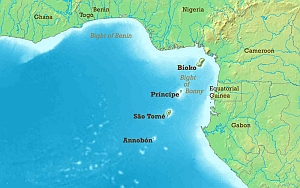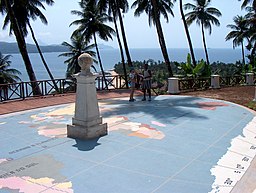
Exploring the history and experiences of mixed heritage persons and inter-racial relationships across the world

Exploring the history and experiences of mixed heritage persons and inter-racial relationships across the world
 If there were any places that set the Portuguese in a good position for the soon to follow colonisation and slave trade, it is their discoveries of the islands of the coast of Africa which conveniently where unoccupied. Along with Cape Verde which we will cover in another chapter, the islands of São Tomé and Príncipe were natural bases for trade with what was then the inhospitable African continent. This established position meant that Portugal’s share of the planet as defined in the 1494 Tordesilhas Treaty with Spain included the more established routes round Africa and into the Indian Ocean. Luckily or dishonestly, they also got Brazil in the Americas that many historians believe Portugal knew about when the treaty was drawn up.
If there were any places that set the Portuguese in a good position for the soon to follow colonisation and slave trade, it is their discoveries of the islands of the coast of Africa which conveniently where unoccupied. Along with Cape Verde which we will cover in another chapter, the islands of São Tomé and Príncipe were natural bases for trade with what was then the inhospitable African continent. This established position meant that Portugal’s share of the planet as defined in the 1494 Tordesilhas Treaty with Spain included the more established routes round Africa and into the Indian Ocean. Luckily or dishonestly, they also got Brazil in the Americas that many historians believe Portugal knew about when the treaty was drawn up.
It is quite interesting that both Cape Verde and these islands where not occupied at the time of the Portuguese discoveries considering that the Canary Islands, off the coast of North Africa and just north of Cape Verde, and nearly all the islands of the coast of East Africa have recognisable aboriginal or native populations. The Canaries’ original pre-European population are likely to be descendants of Arab Berber populations. Noticeably on the east coast of Africa, the Seychelles, the only African country to have a smaller population in Africa than these islands, was claimed to be un-inhabited when sighted by the Portuguese explorer Vasco Da Gama.
 Considering the un-inhabited state of these islands when discovered in 1470, it not surprising that the whole of the current population are descendants of settlers, slaves and immigrants. The first settlement was on São Tomé and was established in 1493 and Príncipe was settled in 1500. Both settlements were in the form of a land grant made by the Portuguese crown. Early settlement was slow with the earliest settlers were classified "undesirables" sent from Portugal and this practice continued up until independence. In 1492 influenced by the Spanish Inquisition, Jews were regarded as undesirable and thousands were exiled to these islands and Cape Verde. However when the settlers started the growing sugar in the rich volcanic soils, it attracted other settlers and increased the importation of slaves from the African mainland, mainly from Benin, Gabon, and Congo. By the mid-1500s, the islands were a major exporter of sugar and were taken over and administered by the crown by 1573.
Considering the un-inhabited state of these islands when discovered in 1470, it not surprising that the whole of the current population are descendants of settlers, slaves and immigrants. The first settlement was on São Tomé and was established in 1493 and Príncipe was settled in 1500. Both settlements were in the form of a land grant made by the Portuguese crown. Early settlement was slow with the earliest settlers were classified "undesirables" sent from Portugal and this practice continued up until independence. In 1492 influenced by the Spanish Inquisition, Jews were regarded as undesirable and thousands were exiled to these islands and Cape Verde. However when the settlers started the growing sugar in the rich volcanic soils, it attracted other settlers and increased the importation of slaves from the African mainland, mainly from Benin, Gabon, and Congo. By the mid-1500s, the islands were a major exporter of sugar and were taken over and administered by the crown by 1573.
The early European settlers came without women and like elsewhere in the Portuguese empire, the settlers reproduced with the slave women. This led to a distinguishable mixed population, identified as mestizo or creole who at some point reached a tipping point to become the majority ethnic mix on the islands.
The larger, more productive sugar plantations of the West Indies and the Americas led to the decline of the islands’ sugar exports and the new economic activity centred on slavery until well after Portugal abolished slavery in 1876. Like elsewhere in the world, particularly in the Portuguese colonies, the abolishment of slavery lead to unsavoury labour practises such as forced paid labour. The abuses were necessary to man the developing new cash crops of coffee and cocoa which replaced slavery as the economic foundation of the islands. Cocoa remains a major export crop.
Throughout the 19th and early 20th century, labour remained an issue for the islands especially since the Creole or mixed population saw plantation work as slave work and resisted being forced to do such work. Angolans under restricted and cruel conditions were brought in to man the plantations but the conditions led to unrest and conflict that in 1953 led to riots and the ‘Batepá Massacre’ in which led to the death of over 1,000 workers.
 With Portugal’s reluctance to hold onto her colonies after events back home and the rising independence movements around the world, the islands achieved independence on 12 July 1975. There has been some political upheaval since but none of it appears to be ethnicity based as the majority of the population of today’s 160,000 strong population identify as mestizo or mixed. Other smaller identifiable ethnic groups on the islands include descendants of freed slaves known as Forros, and a number of African related groups such as the contract labourers from Angola, Mozambique, and Cape Verde known as Serviçais, Tongas who are children of Serviçais born on the islands, Angolares reputedly descendants of shipwrecked Angolan slaves and now predominationly fishermen, Europeans and Asians including Macanese people of mixed Portuguese and Chinese ancestry. Actual numbers do not appear to be published.
With Portugal’s reluctance to hold onto her colonies after events back home and the rising independence movements around the world, the islands achieved independence on 12 July 1975. There has been some political upheaval since but none of it appears to be ethnicity based as the majority of the population of today’s 160,000 strong population identify as mestizo or mixed. Other smaller identifiable ethnic groups on the islands include descendants of freed slaves known as Forros, and a number of African related groups such as the contract labourers from Angola, Mozambique, and Cape Verde known as Serviçais, Tongas who are children of Serviçais born on the islands, Angolares reputedly descendants of shipwrecked Angolan slaves and now predominationly fishermen, Europeans and Asians including Macanese people of mixed Portuguese and Chinese ancestry. Actual numbers do not appear to be published.
It is interesting that the mixed race people of the island are describes as mestizo or creole as compared to mulatto which is the Portuguese terms used for European/African mix. However, officially the colonialists did use mestizo and that appears to hav stuck. The creole description comes from the three local Portuguese based creole languages spoken on the islands.
Links